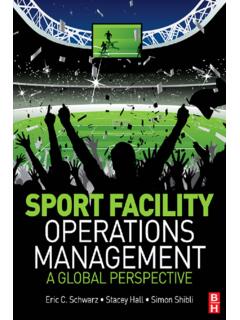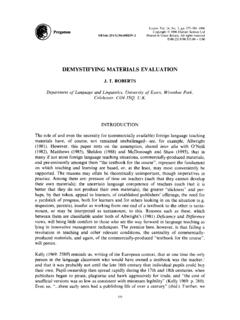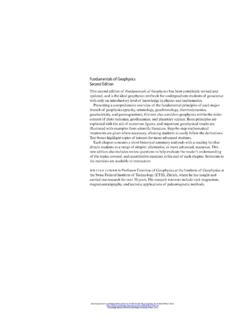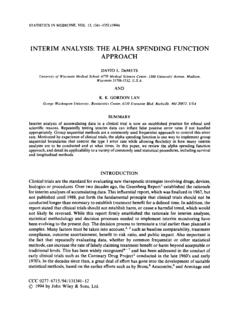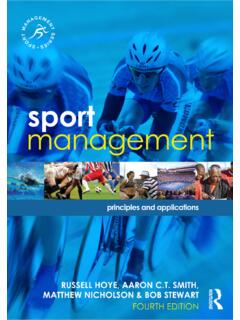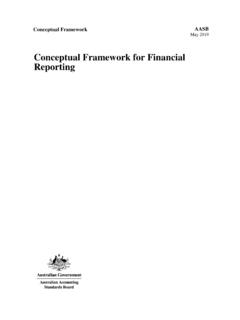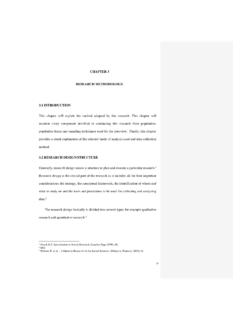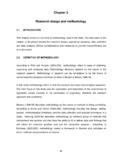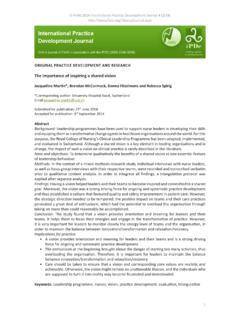Transcription of Setting a research question, aim and objective
1 Nurse Researcher Question development Setting a research question, aim and objective Cite this article as: Doody O, Bailey ME (2016) Setting a research question, aim and objective . Nurse Researcher. 23, 4, 19-23. Date of submission: November 4 2014. Date of acceptance: May 27 2015. Correspondence Abstract Owen Doody PhD, MSc, BSc Aim To describe the development of a research into research . This necessitates engaging with the is a lecturer at the Department of Nursing and Midwifery, question, aim and objective . relevant published literature and knowledgeable people. University of Limerick, Limerick, Republic of Ireland Background The first steps of any study are Conclusion This paper identifies the issues to be Maria E Bailey MSc, BSc, developing the research question, aim and objective . considered when developing a research question, aim RNT, RGN is a lecturer at the Subsequent steps develop from these and they and objective . Understanding these considerations will Department of Nursing and govern the researchers' choice of population, enable researchers to effectively present their research Midwifery, University of Limerick, Republic of Ireland Setting , data to be collected and time period for the question, aim and objective .
2 Study. Clear, succinctly posed research questions, Peer review aims and objectives are essential if studies are to Implications for practice To conduct successful This article has been subject to double-blind review and be successful. studies, researchers should develop clear research has been checked using questions, aims and objectives . antiplagiarism software Discussion Researchers developing their research Author guidelines questions, aims and objectives generally experience Keywords research question, research aim, research difficulties. They are often overwhelmed trying to objective , study development, nursing research , nr-author-guidelines convert what they see as a relevant issue from practice novice researchers Introduction researchers work through the different steps of the DEFINING THE research question is a particularly design cycle, reviewing the literature, integrating significant step in research as it narrows the theory and developing a conceptual framework research aim and objective down to specific areas (Hennink et al 2011).
3 The study will address (Creswell 2014, Johnson and Novice researchers are often overwhelmed and Christensen 2014). research questions are vital as bewildered when trying to convert what they see they guide the choice of methodology, methods, as relevant issues from practice into a study. This sample, sample size, data collection instrument and difficulty arises as they progress their work and they data analysis techniques (Lipowski 2008). feel they know what they need to answer. Selecting and constructing a good research Only by consulting a supervisor and/or other question is one of any study's most difficult aspects knowledgeable people about the research and (Blaikie 2007, 2009, Aslam and Emmanuel 2010). critical evaluation of the relevant published Despite this, there is little direction on creating literature can researchers develop research good research questions (Lipowski 2008). They questions, aims and objectives . Developing a do not appear spontaneously and the ability to research question is an interactive and inductive pose good questions is a skill that can be refined endeavour that takes place over time.
4 And developed with direction and collaboration A clear research question is vital and sets the from colleagues and supervisors (Thabane et al scene for development of a clear research aim and 2009). Importantly, research questions are not objective that are inextricably linked (Martindale static: they change, adapt or are refined when and Taylor 2014). RCNi / NURSE RESEARCHER March 2016 | Volume 23 | Number 4 19. Downloaded from by ${ } on Jun 20, 2016. For personal use only. No other uses without permission. Copyright 2016 RCNi Ltd. All rights reserved. Nurse Researcher Table 1 Types of quantitative research question and Setting the limits by revealing the boundaries of the study and highlighting the type of data to be Type Question collected (White 2009). Descriptive Seeks to quantify responses to one or more variables Quantitative research questions These tend to Often begins with What is ?' or What are ?' be precise and can be categorised as descriptive', comparative' or relationship' (Table 1).
5 Words such Comparative Seeks to compare two or more groups for some outcome variable as do', does', is' or are' should be avoided as they Often uses words such as compare' invite yes'/ no' responses. When it involves two groups it can be written as: What is Appropriate questions should highlight the the difference in (dependent variable) between (group 1) and population, dependent variables and design (group 2)?' (historical, descriptive, correlational, experimental, Can be extended to three or more groups by replacing the word causal-comparative, quasi experimental), and between' with among' the link between the research question and the Can be causal in nature, such as the effect of X on Y design (Onwuegbuzie and Leech 2006, Kloda Such causal questions are implicitly comparative in nature when and Bartlett 2013). In comparative/relationship a comparison is made between a group where X is involved and research questions, independent variables a group where X is not involved should also be highlighted.
6 qualitative research questions are flexible, Relationship Is concerned with trends between or among two or more variables adaptable and non-directional (Creswell 2013). Often uses words such as relate', relationship', association' They seek to determine or discover a process, and trend' or define experiences. They are normally used to Relationship questions involving two variables usually can be try to understand particular educational, familial written using: What is the relationship between (independent or social processes or experiences that happen in variable) and (dependent variable) among (population)?' a specific location and/or context (Marshall and Can be extended to three or more variables by replacing the word Rossman 2011). They usually describe and address between' with among' what' and how' questions, avoiding words such as affect', influence', compare' and relate'. (Onwuegbuzie and Leech 2006). qualitative research questions These can represent Researchers should: broad or central areas of research or specific areas Develop a research problem that matches your or sub-categories (Creswell 2013).
7 Sub-questions interests, background, training and publications. can address important concerns and difficulties to Base research on current evidence. be resolved or describe the context. Like quantitative The research question should logically present questions, qualitative questions link to research each step in a progression from what is known to design, including historical/narrative, case study, important issues that are not. ethnography, phenomenology, grounded theory and Do not try to be research trendy'. Do not follow autoethnography. a trend or issue with little evidence from the Generally, these questions are non-directional literature or little idea of how it will add to the and use words that state that the study will: knowledge base. discover' (grounded theory), explain' or seek to Avoid topics. Look at clearly defined research understand' (ethnography), explore a process'. problems instead. (case study) or describe the experiences'. Stay focused. You will find many things of (phenomenology).
8 Interest along the path, but you should ask Researchers can often find developing qualitative yourself: Is this related to what I want to uncover questions difficult (Agee 2009). To help researchers or just a point of interest?' think about the different types and purposes of their studies, constructs for question types are presented research questions in Table 2. Comparative questions are often research questions can be developed from overlooked in qualitative research . Onwuegbuzie and theoretical knowledge, previous research or Leech (2007) described four measures that compare: experience, or a practical need at work (Parahoo 1. Participants pairwise (pairwise sampling 2014). They have numerous roles, such as designs). identifying the importance of the research , 2. Two or more subgroups (subgroup sampling providing a framework , direction and cohesion, designs). 20 March 2016 | Volume 23 | Number 4 RCNi / NURSE RESEARCHER. Downloaded from by ${ } on Jun 20, 2016. For personal use only.
9 No other uses without permission. Copyright 2016 RCNi Ltd. All rights reserved. Question development 3. Two or more members of the same subgroup, The authors suggest that once the research topic wherein one or more members represents a has been identified, the researcher should begin sub-sample of the full sample (nested sampling framing the research question by listing all the designs). questions that could be researched. This may be a 4. Two or more subgroups that are extracted from large or small list with questions interconnected or different levels of a study (multilevel sampling very different. Forming the right questions should designs). be seen as an iterative process that occurs through continually engaging in reading and refining ones Mixed-methods studies Researchers conducting ideas at all stages (Maxwell 2013). these studies can choose to develop separate Hulley et al's (2007) criteria for quantitative quantitative questions and qualitative questions research are: or develop a mixed methods question depending Feasible.
10 On the study (Creswell 2009). Separate quantitative Interesting. and qualitative questions are appropriate when the Novel . approaches, not the mixed methods or integrative Ethical. component of the study, are the focus (Tashakkori Relevant. and Teddlie 2010). This identifies the significance These criteria are collectively known as FINER. of the qualitative and quantitative phases of the Cooke et al's (2012) characteristics of qualitative study and their collective power (Creswell and Plano research are: Clarke 2011). Sample The development of a mixed methods question Phenomena of interest should reflect the procedures or the content and Design not include separate quantitative and qualitative Evaluation questions (Creswell 2009, Tashakkori and Teddlie research type 2010). This suggests that there is some integration These characteristics are collectively known as or linking between the study's quantitative and SPIDER. Researchers informed by these criteria qualitative phases (Tashakkoria and Teddlie 2010, and characteristics are likely to identify important Creswell and Plano Clark 2011).
